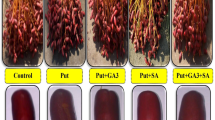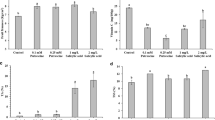Abstract
Phenylalanine ammonia-lyase (PAL) is a biochemical marker of environmental stress and plays a pivotal role in phenolic synthesis. Lower ROS levels and oxidative damage were observed in grafted plants; moreover, the rootstocks have a profound influence on the biochemical composition, especially of phenolic compounds. Regarding the importance of the effect rootstocks have on scion in pistachio trees, this study was carried out to assess and compare three pistachio cultivars (Ahmadaghaii, Ohadi and Kallehghuchi) on four rootstocks (Mutica, Ahli, Sarakhs and Atlantica). PAL activity, phenolic compounds, and flavonoid and anthocyanin contents in leaves, flowers and fruits were measured for the selection of the most suitable and compatible rootstock/scion resistant to environmental stresses. The results showed that PAL activity was different among the cultivars and organs. A positive correlation was observed between PAL activity and phenolic compounds in the leaves and flowers of Mutica-Ahmadaghaii, suggesting that it was more resistant than the others to environmental stresses. PAL activity and total phenolics in pistachio fruits suffered a decrease when the maturation processes began. The hulls of the pistachio fruits contained high levels of phenolic compounds, especially in Mutica-Ahmadaghaii, suggesting its function as a protective layer and a defense chemical against ultraviolet radiation and pathogens. Our results indicated the presence of a number of bioactive compounds in kernels with the highest amount belonging to Mutica-Ahmadaghaii. Therefore, we concluded that pistachio rootstocks mighy affect the antioxidant compounds in kernels.


Similar content being viewed by others
References
Agati G, Mattini P, Goti A, Tattini M (2007) Chloroplast located flavonoids can scavenge singlet oxygen. New Phytol 174:77–89
Ahsan N, Lee DG, Lee SH, Lee KW, Bahk JD, Lee BH (2007) A proteomic screen and identification of water logging-regulated proteins in tomato roots. Plant Soil 295:37–51
Arcas MC, Botia JM, Ortuno AM, Del-Rio JA (2000) UV irradiation alters the levels of flavonoids involved in the defence mechanism of Citrus aurantium fruits against Peniillium digitatum. Eur J Plant Pathol 106:617–622
Ballistreri G, Arena E, Fallico BE (2009) Influence of ripeness and drying process on the polyphenols and tocopherols of Pistacia vera L. Molecules 14:4358–4369
Boudet AM (2007) Evolution and current status of research in phenolic compounds. Phytochemistry 68:2722–2735
Bradford MM (1976) A rapid and sensitive method for the quantitation of microgram quantities of protein utilizing the principle of protein dye binding. Anal Biochem 72:248–254
Buchanan B, Cruissem W, Jones R (2000) Molecular biology of plants. American Society of Plant Physiology, sect. 8, pp 379–400
Cheng SY, Wang Y, Liu WH, Du HW, Chen KS (2005) Effects of plant growth regulators on phenylalanine ammonia-lyase (PAL) activities in leaves of Ginkgo biloba. J Plant Resour Environ 14:20–22
Cordenunsi BR, Nascimento JR, Genovese MI, Lajolo FM (2002) Influence of cultivar on quality parameters and chemical composition of strawberry fruits grown in Brazil. J Agric Food Chem 50:2581–2586
Ding CK, Chachin K, Ueda Y, Imahori Y, Wang CY (2001) Metabolism of phenolic compounds during loquat fruit development. J Agric Food Chem 49:2882–2888
Dixon RA, Paiva NL (1995) Stress induced phenylpropanoid metabolism. Plant Cell 7:1085–1097
Doster MA, Michailides TJ (1995) The relationship between date of hull splitting and decay of pistachio nuts by Aspergillus species. J Plant Dis 79:766–769
Evrenosoglu Y, Alan O, Ozdemir N (2010) Leaf phenolic content of some squash rootstocks used on watermelon (Citrullus lanatus thunb.) Matsum and Nakai) growing and phenolic accumulation on grafted cultivar. Afr J Agric Res 5:732–737
Feng SQ, Chen XS, Zhang CY, Liu XJ, Liu ZC, Wang HB, Zhou CH (2008) Relationship between anthocyanin biosynthesis and related enzymes activity in Pyrus pyrifolia mantianhong and its bud sports aoguan. Agric Sci China 7:1318–1323
Filkowski J, Kovalchuk O, Kovalchuk I (2004) Genome stability of vtc1, tt4, and tt5 Arabidopsis thaliana mutants impaired in protection against oxidative stress. Plant J 38:60–69
Gijon MC, Gimenez C, Perez-López D, Guerrero J, Couceiro JF, Moriana A (2010) Rootstock influences the response of pistachio (Pistacia vera L. cv. Kerman) to water stress and rehydration. Sci Hortic 125:666–671
Goli AH, Barzegar MA, Sahari MA (2005) Antioxidant activity and total phenolic compounds of pistachio (Pistachia vera) hull extracts. Food Chem 92:521–525
Hamouz K, Lachman J, Cepl J, Dvorak P, Pivec V, Prasilova M (2007) Site conditions and genotype influence polyphenol content in potatoes. Hort Sci 34:132–137
He Y, Zhu Z, Yang J, Ni X, Zhu B (2009) Grafting increases the salt tolerance of tomato by improvement of photosynthesis and enhancement of antioxidant enzymes activity. Environ Exp Bot 66:270–278
Hura T, Hura K, Grzesia S (2008) Contents of total phenolics and ferulic acid and PAL activity during water potential changes in leaves of maize single-cross hybrids of different drought tolerance. J Agron Crop Sci 194:104–112
Jakobek L, Seruga M, Voca S, Sindrak Z, Dobricevic N (2009) Flavonol and phenolic acid composition of sweet cherries (cv. Lapins) produced on six different vegetative rootstocks. Sci Hortic 123:23–28
Kliebenstein DJ (2004) Secondary metabolites and plant/environment interactions: a view through Arabidopsis thaliana tinged glasses. Plant Cell Environ 27:675–684
Koundouras S, Tsialtas IT, Zioziou E, Nikolaou N (2008) Rootstock effects on the adaptive strategies of grapevine (Vitis vinifera L. cv. Cabernet–Sauvignon) under contrasting water status: leaf physiological and structural responses. Agric Ecosyst Environ 128:86–96
Lee JM, Oda M (2003) Grafting of herbaceous vegetable and ornamental crops. Hortic Rev 28:61–124
Lister CE, Lancaster JE, Walker JR (1996) Developmental changes in enzymes biosynthesis in the skins of red and of flavonoid green apple cultivars. J Sci Food Agric 71:313–330
Montero TM, Molla EM, Esteban RM, Lopez-Andreu FJ (1996) Quality attributes of strawberry during ripening. Sci Hortic 65:239–250
Mozetic B, Trebse P, Simcic M, Hribar J (2004) Changes of anthocyanins and hydroxycinnamic acids affecting the skin colour during maturation of sweet cherries (Prunus avium L.). Lebensm-Wiss Technol 37:123–128
Reyes-Carmona J, Yousef GG, Martinez-Peniche RA, Lila MA (2005) Antioxidant capacity of fruit extracts of blackberry (Rubus sp.) produced in different climatic regions. J Food Sci 70:497–503
Rhee JY, Lee SH, Singh AP, Chung GC, Ahn SJ (2007) Detoxification of hydrogen peroxide maintain the water transport activity in fig leaf ground (Cucurbita ficifolia) root system exposed to low temperature. Physiol Plant 130:177–184
Rice–Evans CA, Miller MA, Paganga G (1997) Antioxidant properties of phenolic compounds. Trends Plant Sci 2:152–159
Robards K, Prenzler PD, Tucker G, Swatsitang P, Glover W (1999) Phenolic compounds and their role in oxidative processes in fruits. Food Chem 66:401–436
Satisha J, Prakash GS, Murti GSR, Upreti KK (2005) Response of grape genotypes for water deficit: root shoot growth and endogenous hormones. Indian J Plant Physiol 10:225–230
Shao L, Shu Z, Sun SH, Peng CH, Wang X, Lin ZH (2007) Antioxidation of anthocyanins in photosynthesis under high temperature stress. J Integr Plant Biol 49:1341–1351
Silva EM, Souza JN, Rogez H, Rees JS, Larondelle Y (2007) Antioxidant activities and polyphenolic contents of fifteen selected plant species from the Amazonian region. Food Chem 101:1012–1018
Singleton VL, Rossi JA (1965) Colorimetry of total phenolics with phosphomolybdic–phosphotungstic acid reagents. Am J Enol Vitic 16:144–158
Sobhana P, Thomsa M, Krishnakumar R, Jacob J (2000) Can there be possible genetic conflict between genetically divergent rootstocks and scions in bud grafted plants? In: National Symposium on Recent Trends in Plant Science Research, University of Kerala, Trivandrum, India
Spinardi AM, Visai C, Bertazza G (2005) Effect of rootstock on fruit quality of two sweet cherry cultivars. Acta Hortic 667:201–206
Tomaino A, Martorana M, Arcoraci T, Monteleone D, Giovinazzo C, Saija A (2010) Antioxidant activity and phenolic profile of pistachio (Pistacia vera L., variety Bronte) seeds and skins. Biochimie 92:1115–1123
Velioglu YS, Mazza G, Gao L, Oomah BD (1998) Antioxidant activity and total phenolics in selected fruits, vegetables, and grain products. J Agric Food Chem 46:4113–4117
Vogt T (2010) Phenylpropanoid biosynthesis. Mol Plant 3:2–20
Wagner GJ (1979) Content and vacuole/extra vacuole distribution of neutral sugars free amino acids, and anthocyanins in protoplast. Plant Physiol 64:88–93
Wang JW, Zheng LP, Wu JY, Tan RX (2006) Involvement of nitric oxide in oxidative burst phenylalanine ammonia-lyase activation and taxol production induced by low-energy ultrasound in Taxus yunnanensis cell suspension cultures. Nitric Oxide 15:351–358
Zhishen J, Mengcheng T, Jianming W (1999) The determination of flavonoid contents in mulberry and their scavenging effects on superoxide radicals. Food Chem 64:555–559
Acknowledgments
The authors acknowledge Shahid Bahonar University for providing research funds and Iran’s Pistachio Research Institute (IPRI) for providing the research material.
Author information
Authors and Affiliations
Corresponding author
Additional information
Communicated by W. Bilger.
Rights and permissions
About this article
Cite this article
Nadernejad, N., Ahmadimoghadam, A., Hossyinifard, J. et al. Effect of different rootstocks on PAL activity and phenolic compounds in flowers, leaves, hulls and kernels of three pistachio (Pistacia vera L.) cultivars. Trees 27, 1681–1689 (2013). https://doi.org/10.1007/s00468-013-0915-8
Received:
Revised:
Accepted:
Published:
Issue Date:
DOI: https://doi.org/10.1007/s00468-013-0915-8




